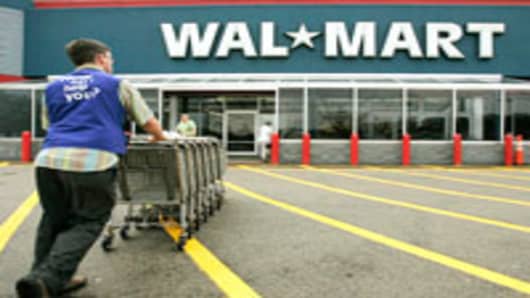Shoppers expect the tags on Wal-Mart items to have rock-bottom prices. In the future they may also have information about the product’s carbon footprint, the gallons of water used to create it, and the air pollution left in its wake.
As the world’s largest retailer, Wal-Mart Stores is on a mission to determine the social and environmental impact of every item it puts on its shelves. And it has recruited scholars, suppliers, and environmental groups to help it create an electronic indexing system to do that.
The idea is to create a universal rating system that scores products based on how environmentally and socially sustainable they are over the course of their lives. Consider it the green equivalent to nutrition labels.
Rather than a retailer or a product supplier’s focusing on only a few sustainability goals — lower emissions or water conservation or waste reduction — the index would help them take a broader view of sustainability by scrutinizing and rating all sorts of environmental and social implications.
Did this T-shirt come from a cotton crop that was sprayed with pesticide? Was excessive packaging used to ship these diapers?
Wal-Mart’s goal is to have other retailers eventually adopt the indexing system, which will be created over the next five years.
“We have to change how we make and sell products,” Michael T. Duke, Wal-Mart’s president and chief executive, plans to tell about 1,500 of the company’s suppliers and employees on Thursday at a “sustainability meeting,” according to a copy of his prepared remarks. “We have to make consumption itself smarter and sustainable.”
The only thing less likely than a Wal-Mart meeting that sounds as if it were dreamed up by liberal-arts environmentalists may be that a number of scholars and environmental groups say that Wal-Mart is the only entity capable of making “sustainable consumption” a retailing reality.
“Nobody else could pull this off,” said Michelle Harvey at Environmental Defense Fund, one of the groups involved in the creation of the index.
The question, of course, is whether even Wal-Mart can make it happen.
“I think it’s going to be a lot of work for a lot of people,” said Jon Johnson, a professor in the Sam M. Walton College of Business at the University of Arkansas, whom the company asked to help create the index, along with Jay Golden at Arizona State University. “But obviously we’re optimistic about the prospects.”
Joe Cavaliere, a senior vice president for customer development at Unilever, a big Wal-Mart supplier, called the indexing idea “a great move forward for the industry.”
Wal-Mart’s sheer size has long enabled it to create ripple effects throughout corporate America whenever it adopts new ways of doing business.
For instance, Len Sauers, the vice president for global sustainability at Procter & Gamble , recalls that a few years ago, when his company and a few others began selling concentrated laundry detergent that uses 50 percent less water — and allows for a smaller container using less plastic — that version was slow to catch on.
In 2007, Wal-Mart decided it would sell only the concentrated detergents.
“Because of Wal-Mart’s leadership in that area, they were able to set a standard for the entire industry,” Mr. Sauers said. “That opened the door to allow it to progress very, very quickly.”
Procter & Gamble said sharing the new sustainability index across the industry was important.
“The last thing a supplier really wants is when you’re doing a separate index for every retailer,” said Tim Marrin, associate director of external relations for Procter & Gamble. “Wal-Mart has invited the Targets, the Costcos, the Tescos of the world,” he said, “to come up with a solution so that there are not 5, 10, 15, 20 different standards that retailers are implementing in their markets.”
But creating a single set of measurements for the entire retailing industry will be complicated. For one thing, some suppliers have concerns about their proprietary information.
And environmentally sustainable production and distribution methods will not necessarily be cheap.
“The first question is always, ‘It’s going to cost more,’ ” John E. Fleming, Wal-Mart’s chief merchandising officer, said in an interview this week. “But you know, I think we’ve demonstrated time and time again, if you reduce packaging, if you reduce energy, the costs go down.”
Wal-Mart plans to begin by asking its more than 100,000 suppliers around the world to answer 15 simple questions about the sustainable practices of their companies. Questions include “Have you set publicly available greenhouse gas reduction targets? If yes, what are those targets?”
The largest United States suppliers will be asked to respond by October. Deadlines outside the United States have not been set.
Wal-Mart said suppliers that choose not to participate would not be penalized, but warned, “then they’re probably less relevant to us.”
Whatever grumbling the index might create, Wal-Mart executives said that more and more consumers, especially those born from 1980 to 2000, will be making purchasing decisions based not only on price but also on which products do the least harm to the environment and the people, often in poorer countries, who produce them.
“These younger consumers, they care deeply about this regardless of what happens in the economy,” Mr. Fleming said. “When I go around to colleges and universities to recruit, sustainability is tops on their list. So I think this will help us build a better business model.”
If successful, the index could compel manufacturers and suppliers to create more sustainable products.
“If we could take a snapshot of products today in the store and then fast forward 10 years from now,” said Matt Kistler, Wal-Mart’s senior vice president for sustainability, we would see “dramatic changes.”



